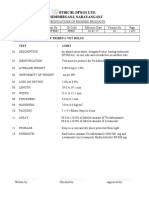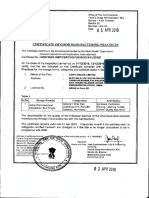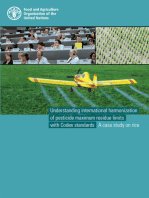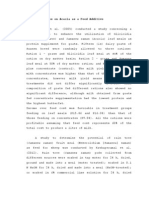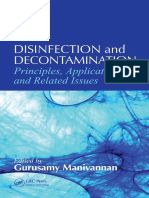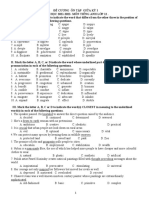Sodium Metabisulphite and Sodium Benzoate PDF
Sodium Metabisulphite and Sodium Benzoate PDF
Uploaded by
Pamela Anne CanlasCopyright:
Available Formats
Sodium Metabisulphite and Sodium Benzoate PDF
Sodium Metabisulphite and Sodium Benzoate PDF
Uploaded by
Pamela Anne CanlasOriginal Title
Copyright
Available Formats
Share this document
Did you find this document useful?
Is this content inappropriate?
Copyright:
Available Formats
Sodium Metabisulphite and Sodium Benzoate PDF
Sodium Metabisulphite and Sodium Benzoate PDF
Uploaded by
Pamela Anne CanlasCopyright:
Available Formats
155
Ife Journal of Science vol. 14, no. 1 (2012)
CYTOGENETIC EFFECTS OF TWO FOOD PRESERVATIVES, SODIUM
METABISULPHITE AND SODIUM BENZOATE ON THE ROOT TIPS OF ALLIUM
CEPA LINN.
Onyemaobi, O. I*, Williams, G. O. and Adekoya, K. O.
Department of Cell Biology and Genetics, University of Lagos, Akoka, Lagos State
*Corresponding Author:
e-mail: rosyolivehart@yahoo.com
Received: March, 2012; Accepted June, 2012
ABSTRACT
Allium cepa assay has been used extensively to determine the cytotoxicity and genotoxicity of compounds on
plants and animals. The cytogenetic effects of two commonly used food preservatives, sodium benzoate and
sodium metabisulphite were evaluated using the A. cepa assay. The parameters scored for the different
concentrations of the compounds tested are: root length, chromosomal aberrations and Mitotic Index. The
Mitotic Index (MI) decreased with increasing concentration of both sodium benzoate and sodium
metabisulphite. Cytological aberrations observed were clumping, fragmentation, pulverization, lagging,
binucleate cells and reduction in chromatin materials. Clumping and fragmentation were the most frequent
aberrations. The percentage of chromosomal aberrations at mitosis increased with increase in concentration of
the food preservatives. The effects of sodium metabisulphite at the different concentrations in this study were
very detrimental as more aberrations were recorded even after the recovery experiment. The results of this
experiment show that these additives had irreversible cytotoxic effects at some levels of dosage. It supports the
call for the banning of these substances as food preservatives.
Key words: Chromosome Aberration, Food Preservatives, Mitotic Index; Allium cepa Assay.
INTRODUCTION:
Food additives are substances not
normally consumed as food and not usually used
as typical food ingredients but used as additives in
foods or pharmaceuticals to achieve specified
chemical effects in the final food product.
Currently, there are over 3000 additives with
different functions in use in the food industry and
they are classified based on their functions. For
example, they could be classified as preservatives,
colourings, non-nutritive sweeteners, ingredient
improvers and many more. As natural
preservatives, they are as effective as synthetic
preservatives
(Etteh 2003; Doyle, 2007;
Turkoglu, 2007; Daoliang and Chunjiang, 2009).
The need for food preservation will
remain for all time if the world is to cater for the
global population which is ever increasing at an
alarming geometric progression (FAO/WHO,
1994). The need for food preservation will
increase as new food sources are expected to cater
for the ever-increasing global human population
(Kumar and Panneerselvam, 2007). Traditional
methods of preservation usually aim to shut out
air, moisture, and microorganisms (Aworh, 2008).
Synthetic/chemical preservation are generally
seen as an almost perfect method of ensuring food
availability. They are also commonly used because
it has been reported that they have a longer shelf
life and they assist with contamination by
inhibiting the growth of moulds and bacteria.
Many scientific investigations have shown
that some of these chemical preservatives used,
especially those with antimicrobial functions have
adverse effect on health in different test systems
(Turkoglu, 2007). Numerous potentially
mutagenic chemicals have been studied mainly
because they can cause damaging and heritable
changes in the genetic material, which are usually
not immediately expressed. It has also been
demonstrated that many of the chemical food
preservatives are decomposed or converted into
other by-products such as sulphites, disulphides or
sulphides and many more have a variety of
biological effects that could be antimicrobial,
antioxidizing or chelating (Armando and Pilar,
2006).
Sodium benzoate occurs naturally in several
fruits like the apples, cranberries, prunes and in
spices like cinnamon and cloves. The presence of
sodium benzoate in these foods does not make it
function as a preservative. It is also present in
beers, tomatoes and other sauces. It is usually
produced chemically and added as a preservative
in foods where it has major antimicrobial
function, being most effective against yeast and
mould. Sodium benzoate is a common
preservative in soft drinks because it suppresses
the growth of bacteria and fungi under the acidic
156
Onyemaobi et al.: Cytogenetic Effects of Two Food Preservatives
conditions found in carbonated beverages. It has
excellent solubility in water and it is sparingly
soluble in alcohol (Seager and Slabaugh, 2000).
Sodium metabisulphite is also known as E223 in
the food industry. Food items containing this
preservative are some fruit juices, concentrated
soft drinks, beer and wine. Sulphites are primarily
used as antioxidants or antimicrobial agents to
prevent or reduce the discolouration of lightcoloured fruits and vegetables. Sodium
metabisulphite is an excellent anti-melanosis
additive for sea food (Omar, 1998). It can decrease
the vitamin composition, especially of vitamin B1
in food; as an additive, non-sensitives are safe
(Luck et al., 1997).
There are various reports on the abuse
of some food additives but to prevent this and also
to ensure that consumers have food products of
suitable quality, national regulatory authorities of
each country and the Codex Alimentarius
Commission publish lists of permitted additives,
the modes of their administration and
recommended dosages in specified foods. In
Nigeria, the National Agency for Food and Drug
Administration and Control (NAFDAC) has
adopted the Codex General Standard for Food
Additives (GSFA) and uses the permitted list of
additives attached to that standard (Etteh, 2003).
The accepted daily intake (ADI) is an estimate of
the amount of food additive expressed on a body
weight basis that can be ingested daily over a life
time without appreciable health risk. The ADI of
benzoates is 0-5 mg/kg of body weight while that
of sulphites is 0-0.7 mg/kg of body weight
(FAO/WHO, 1994).
The Allium assay was introduced by
Levan in 1938; it is a short term biological assay
and has been proposed as a standard method for
toxicity testing. Some advantages of Allium assay
include the fact that A. cepa is readily available all
year round, it is relatively easy to handle, it
provides good mitotic spreads for analysis, it is
economical and shows a good correlation with a
number of other test systems (El-shahaby et al.,
2003; Fiskesjo, 1985). Allium cepa roots contain
oxidase enzyme which activates the conversion of
promutagens into mutagens.
The 1974 World Health Organization
Report Series on food additives reported that
benzoate was toxic to mice, rats, rabbits, guinea
pigs and dogs. It has also been reported that
sodium benzoate and sodium sulphite in the roots
of Vicia faba inhibit DNA synthesis and cause the
formation of anaphase bridges, premature
chromosome condensation leading to pycnotic
nuclei and chromatin erosion in interphase nuclei
(Njagi and Gopalan, 1982). The genotoxicity tests
for benzyl alcohol, benzoic acid and sodium
benzoate have been reported to have mostly
negative effects but some assays were positive
(Turkoglu, 2007). Ishidate and Odashima (1977)
reported positive chromosomal aberration tests in
vitro on Chinese hamster cells grown in culture
with sodium benzoate.
Rencuzogullari et al. (2001a) in their work
on the effect of this food preservative in human
lymphocytes recorded induced chromosome
aberrations and sister chromatid exchanges,
decreased replication and mitotic indices that were
dose-dependent. Sodium metabisulhpite was also
found to have genotoxic effect on the bone
marrow of rats (Kayraldiz and Topaktas, 2007). In
plants, it was also recorded that sodium
metabisulphite induced a significant reduction of
frequency of dividing meristematic cells in
Calendula officinalis (pot marigold) root tips. The
most frequent aberration observed was the
anaphase-telophase bridges. This incidence of
aberrant cells increased proportional to increase
of food additive concentration (Marc and
Capraru, 2008).
MATERIALS AND METHODS
The root tips of Allium cepa (Linn.) were
used as the test system. The dry outer scales were
removed from healthy onion bulbs and the discs
were trimmed at the base with a clean, sharp blade
taking great care not to destroy the root primordia.
The prepared bulbs of Allium cepa were seated on
3
25cm vials filled with tap water for 2-4 days. The
food preservatives, sodium benzoate (E211) and
sodium metabisulphite (E223) were used as the
test substances.
The effect of the test substances on the
onion root tips was conducted using 0.25M,
0.10M, 0.05M and 0.025M of the substances and
the onion bulbs were placed directly on them. In
another setup, there was the initial growth of the
onion bulbs in tap water, the bulbs were
transferred to a series of concentrations of the
two test substances for 3, 6, 9 and 24 treatment
hours. Five bulbs were used for each
concentration and duration of treatment as well as
for the control setup left in tap water. The lengths
of the newly emerged roots were measured before
transfer to the test solutions and also after the 6
Onyemaobi et al.: Cytogenetic Effects of Two Food Preservatives
hours and 24 hours treatment times. A
concentrationresponse curve was drawn with the
EC50 determined by simple interpolation (Taiwo et
al., 2006). After each treatment time, some root
tips were removed and fixed immediately in 1:3
Acetic-Ethanol for 24 hours.
Five root tips were cut from each bulb.
After fixation, the root tip was placed at the centre
of a clean microscope-slide and cut into smaller
bits using dissecting needles. The root tip was
macerated in drops of 1N HCl for hydrolysis for 5
minutes. After maceration, the HCl was mopped
up with filter paper; the root tip was then stained
with two drops of Lactic Acetic Orcein and left for
20 minutes. Afterwards, the cells were squashed
gently and evenly spread (Sharma and Sharma,
1999). Only one root was used per slide and five
slides were made from each bulb. The stained
material on the slide was carefully covered with a
cover-slip ensuring that no air was trapped in the
process. The slide was covered with a sheet of
filter paper and pressed down firmly to remove
any excess stain. Good slides were preserved by
sealing them with colorless nail varnish. Each
treatment was done five times to ensure that the
results obtained were consistent.
A recovery test was also conducted in
order to determine whether the effects induced by
treatments with the test substances were
permanent or whether the roots could recover
from the treatment according to Williams and
Omoh (1996). For this test, the onion bulbs with
newly emerging roots of harvestable lengths were
transferred to 0.25M and 0.025M solutions of
both sodium benzoate and sodium metabisulphite
for 3 hours. After exposure for 3 hours with the
test solutions, the onion bulbs were transferred to
tap water and the water changed after 3, 6, 9, and
24 hours. Five slides for each concentration were
made for 6 hours and 24 hours recovery in water.
Another test was set up whereby 30ml of 0.25M
and 0.025M concentration of sodium benzoate
and sodium metabisulphite (the highest and lowest
concentrations) was prepared separately and then
mixed in a 1:1 ratio. Five slides for each
concentration were made for 3 hours, 6 hours, 9
hours and 24 hours.
157
The prepared slides were placed on a Zeiss
light microscope for viewing. Five random fields
were used per slide for recording of mitotic cells
and aberrations. Photomicrographs of some
slides were made under the X40 objective lens or
the X100 objective (oil immersion lens). The
mitotic indices were calculated by dividing the
number of dividing cells per field by the total
number of cells per field and multiplying the
results by 100. The software package: Statistical
Package for Social Scientists (SPSS Version 17)
was used for other data analysis.
RESULTS
The bulbs placed directly on different
concentrations of sodium metabisulphite and
sodium benzoate showed no root germination
even after five days exposure. In the setup with the
initial germination of the onion bulbs in tap water
for 24 hours before their transfer to the different
concentrations used, it was observed that the
roots emerged faster; the germinated roots were
usually robust, upright and with a characteristic
white colour. The roots of bulbs exposed in
0.25M of sodium metabisulphite are however
sticky, staying attached to each other for support
and a loss of the characteristic white colour that
tapers to the root tips. This effect was also
observed in other treatments with higher
concentrations and duration of exposure of
sodium metabisulphite and sodium benzoate. It
was observed that there were decreases in the root
length as the concentrations increased (Table 1).
The Effective Concentration 50 (EC50)
computed by interpolation was found to be
0.085M for sodium metabisulphite and 0.075M
for sodium benzoate. Further analysis using
Spearman's correlation was done and it revealed
that sodium metabisulphite had a negative
correlation with a correlation coefficient of (r = 1.00) that was significantly different at p < 0.05
from its control. Sodium benzoate on the other
hand, also had a negative correlation (r = -0.700)
which was not significantly different (p < 0.05)
from the result of its control.
The food preservatives caused a change in
the frequencies of different mitotic stages. The
mitotic cells
Onyemaobi et al.: Cytogenetic Effects of Two Food Preservatives
158
Table 1: Effect of Different Concentrations of sodium Metabisulphite and Sodium Benzoate on Root
Length of Allium cepa.
Concentration (M)
Mean root length before treatment (cm)
Mean root length after 24 hours
treatment (cm)
Growth in % of control
2.25 + 0.147
Sodium
metabisulphite
100
Sodium benzoate
1.75 + 0.229
Sodium
metabisulphite
1.84 + 0.110
Sodium benzoate
Control (0)
Sodium
metabisulphite
1.55 + 0.092
0.025
1.54 + 0.094
2.11 + 0.180
1.15 + 0.047
1.97 + 0.185
62.50
87.55
0.050
1.78 + 0.186
1.53 + 0.169
1.12 + 0.121
1.29 + 0.136
60.86
57.33
0.100
1.63 + 0.143
1.77 + 0.190
0.90 + 0.159
1.61 + 0.207
48.91
71.55
0.250
1.70 + 0.174
1.85 + 0.192
0.74 + 0.108
1.54 + 0.187
40.21
68.44
Sodium benzoate
100
Table 2. Mitotic Index (MI) of Sodium Metabisulphite(SMB) and Sodium Benzoate (SB) at Different
Concentrations and Durations.
Time
Concentration
(M)
3h
6h
9h
24h
SMB
SB
SMB
SB
SMB
SB
SMB
SB
0.000
13.228
12.339
13.228
12.339
13.228
12.339
13.228
12.339
0.025
3.112***
8.353
1.961***
8.034
1.259***
3.416*
0.882***
2.131**
0.050
2.061***
8.433
1.329***
4.215*
0.899***
2.078**
0.181***
1.305**
0.100
2.163***
2.311**
1.326***
1.850**
0.419***
1.451**
0***
0.796**
0.250
1.272***
1.363**
0.426***
0.749**
0***
0.170***
0***
0***
The Mitotic Index (MI) decreases in the two test substances, sodium metabisulphite and sodium benzoate as the duration of
treatment and concentrations increases. When MI = 0, this means that at such treatment periods and concentrations, the test
preservative have a toxic effect on the root cells of A. Cepa
Table 3 Frequenccies and the Different Classifications of Abnormal/Aberrant Cells Observed upon
Treatment of A. cepa Root Tips with sodium metabisulphite and sodium benzoate at Different
Concentrations and Durations.
Duration
of
treatment
(Hours)
Concentrations
(M)
Total no of cells
examined
SMB
SB
Clumping
SMB
SB
Bridge
Fragmentation
SMB
SB
SMB
0.000 (Control)
1013
1013
0.025
964
862
10
0.050
825
747
13
0.100
601
649
11
0.250
629
587
14
16
0.025
867
473
11
0.050
752
688
20
12
0.100
528
649
12
10
0.250
469
534
17
0.025
556
644
17
0.050
556
722
19
0.100
477
689
0.250
448
588
0.025
567
0.050
SB
Pulverization
SB
SMB
SB
Lagging
SMB
Erosion
Reduction
Disintegration
SB
SMB
SB
SMB
SB
SMB
15
11
10
12
10
15
12
10
14
13
10
14
18
11
24
13
11
12
12
15
11
14
16
20
17
16
18
10
11
15
13
10
30
12
704
14
14
13
11
11
553
613
23
16
32
18
12
26
11
11
0.100
353
628
16
23
15
12
31
14
12
10
19
0.250
479
509
11
22
15
38
20
SMB
Binucleate Cells
SB
24
Onyemaobi et al.: Cytogenetic Effects of Two Food Preservatives
159
Table 4: Mitotic cells, % of Mitotic Stages and Mitotic Index Observed upon 3 hours Treatment of A. cepa
Root Tips with 0.025M and 0.250M Concentrations of sodium metabisulphite and sodium benzoate at
Different Durations of Recovery in Tap Water.
Recovery
time
(Hours)
Concent
r-ation
(M)
Total no of cells
examined
SMB
Total
Mitosis
24
Metaphase
Anaphase
Telophase
% Prophase
SB
% Metaphase
SMB
%Anaphase
SB
SMB
% Telophase
SB
SMB
SB
SMB
SB
SMB
SB
SMB
SB
SMB
SB
SMB
1013
1013
134
12
5
60
62
18
24
25
15
31
24
44.78
49.60
13.43
19.20
18.66
12.00
23.13
19.20
0.025
612
635
13
41
21
11
46.15
51.22
7.70
9.76
23.07
12.20
23.07
26.82
0.250
738
701
57.14
60
14.29
28.57
40
0.025
499
572
16
69
25
23
13
43.75
36.23
12.50
11.60
18.75
33.33
25
18.84
0.250
655
868
13
10
46.15
50
15.38
10
23.08
10
15.38
30
0.025
635
743
26
96
12
33
17
22
24
46.15
34.38
7.69
17.70
23.08
22.92
23.08
25
0.250
582
702
20
15
45
46.67
15
6.67
20
6.67
20
40
0.000
(control)
3
Prophase
SB
SMB
SB
Mitotic index
(mean + S. E.)
SMB
13.207
+ 0.681
SB
12.339
+0.475
2.124+
0.305
0.948+
0.151
3.206+
0.418
1.985+
0.224
4.094+
0.367
3.436+
0.461
6.456+
0.538
0.713+
0.145
12.063
+0.837
1.152+
0.173
12.920
+0.901
2.137+
0.255
Table 5: Frequencies and the Different Classifications of Abnormal/Aberrant Cells Observed Upon 3 hours
Treatment of A. cepa Root Tips with 0.025M and 0.250M Concentrations of sodium metabisulphite
and sodium benzoate at Different Durations of Recovery in Tap Water.
Total no of
cells
examined
Clumping
Bridge
SMB
SB
SMB
SB
SMB
1013
1013
0.000
(control)
0.025
612
635
0.250
0.025
738
499
701
572
12
10
8
3
0
0
0
0
6
0
3
0
0
0
0
0
0
3
2
1
0
0
24
0.250
0.025
655
635
868
743
8
4
4
1
0
0
0
0
0
0
6
0
0
0
0
0
3
1
0
2
0
0
0.250
582
702
Recovery
time
(Hours)
Concentration
(M)
Fragmentation
Pulverization
Binucleate
cells
Lagging
SB
SMB
SB
SMB
SMB
SB
SMB
SB
SMB
decreased as the concentrations and duration of
treatment increased, with a large number of the
cells in prophase and the least cells at anaphase.
There was decrease in the Mitotic Index as the
concentration and duration of treatment
increased for both test preservatives (Table 2).
This reduction was more intense in sodium
metabisulphite than in sodium benzoate. The
Two-way ANOVA results of the Mitotic Index of
sodium metabisulphite showed that the means of
the Mitotic Index at all concentrations and
treatment times were significantly different (p <
0.001) from the means of the control. Analysis on
the Two-way ANOVA of the Mitotic Index of
sodium benzoate showed that there was no
significant difference between the means of the
control experiment and the means of 0.025M,
0.050M at 3 hours treatment time and 0.025M at 6
hours treatment time. The means were, however,
significantly different (p < 0.05) at concentrations
of 0.050M, 0.025M and at 6 hours and 9 hours
respectively.
SB
0
Erosion
Reduction
Disintegration
SB
SMB
SB
SMB
10
0
0
14
4
7
3
6
0
0
0
10
0
5
0
0
5
7
2
3
0
0
0
0
0
8
3
4
0
SB
0
Different chromosomal abnormalities
were observed on the treatment slides but none
was observed in the control. Some chromosome
aberrations observed were chromosome
clumping, chromosome bridge and chromosome
fragmentation. An extreme type of fragmentation
was also observed and cells in such state are said to
show pulverization, abnormal condensation,
erosion of the chromatin materials and total
disintegration or reduction of the chromosome
structure (Plates 1-4). Sodium metabisulphite was
observed to have induced more aberrations. It was
also observed that, at higher concentrations and
exposure times, the frequencies of clumped,
pulverized and eroded cells increased. The
cytogenetic and toxicity effects of the test
substances depended on their concentration and
duration of exposure to the root tips.
160
Onyemaobi et al.: Cytogenetic Effects of Two Food Preservatives
Plate 1: Aberrations Induced by Sodium Metabisulphite and Sodium Benzoate
A.
Fragmentation at Prophase
B.
Clumping at Anaphase
C.
Abnormal chromatin fragmentation at early Prophase
D.
Enlarged nucleus at Prophase;
E.
Clumping at Metaphase
Onyemaobi et al.: Cytogenetic Effects of Two Food Preservatives
161
E
Plate 2: Aberrations Induced by Sodium Metabisulphite and Sodium Benzoate
A.
Clumping at Metaphase
B.
Clumping at Prometaphase
C.
Intense clumping and fragmentation of chromosomes
D.
Clumping at Anaphase (upper arrow) and fragmentation (lower arrow)
E.
Fragmentation at Prometaphase
F.
Wavy outlines of chromosomes at Prometaphase
162
Onyemaobi et al.: Cytogenetic Effects of Two Food Preservatives
Plate 3: Aberrations induced by Sodium metabisulphite and Sodium benzoate
A. Nuclear outline normal B. Nuclear outline disrupted;
C. Wavy chromosome outlines; D. Normal Prophase
B
A
Plate 4: Aberrations induced by Sodium metabisulphite and Sodium benzoate
A. Clumping at Metaphase B. Binucleate cells C. Clumping and fragmentation at Prophase
D. Cells apparently devoid of chromatin material
Onyemaobi et al.: Cytogenetic Effects of Two Food Preservatives
The mitotic cells observed increased with
the duration of recovery, with a large number of
the cells in Prophase. After the 3 hours initial
treatment in 0.025M of sodium benzoate, and 3
hours recovery in tap water, all the mitotic stages
were observed but at 0.250M of the same 3 hours
recovery time, metaphase and anaphase stages
were not observed. But after the 24 hours recovery
in tap water, the different mitotic stages were
observed for both 0.025M and 0.250M (Table 5).
Mitotic Index frequencies of both sodium
metabisulphite and sodium benzoate increased as
duration of recovery increased. Aberrations were
observed on the recovery tests of both sodium
metabisulphite and sodium benzoate but there was
a decrease in their frequencies as the recovery
times increased from 6 hours to 24 hours.
Results for the number of mitotic cells,
percentage of mitotic cells, Mitotic Index and
frequencies of aberrant cells observed on
combinations of the test substances, sodium
metabisulphite and sodium benzoate, are shown in
Table 4. It was observed that the mitotic Index
decreased as the duration of treatment increased.
At the 3-hour treatment time, clumping,
fragmentation and pulverization were the only
aberrations observed while at the 24-hour
treatment time, more aberrant cells were observed.
DISCUSSION AND CONCLUSIONS:
Plant systems are sensitive biomonitors of
the cytotoxic and genotoxic effects of different
chemicals both in situ and in the laboratory (Grant,
1999). Positive results monitored in higher plant
systems like the Allium assay indicate the presence
of cytotoxic and/or genotoxic attributes of some
compounds. These also indicate the potential for
direct or indirect risks for other living organisms
(Fiskesjo, 1993).
Growth retardation was observed in
onion root tips exposed to high concentrations
and longer duration of treatment for the two
preservatives. Growth inhibition was estimated as
EC50 which is the effective concentration of a
chemical producing 50% of the total effect. The
results obtained from the EC50 (0.075M for sodium
benzoate and 0.085M for sodium metabisulphite)
indicated that sodium metabisulphite was more
toxic than sodium benzoate when tested with A.
cepa using the root length. Neves et al. (2010)
reported that, using soybean, the decrease in root
length may be owing to the enhanced lignin
production that solidifies the cell wall and restricts
163
root growth. Using cinmethylin, a herbicide, it was
reported that inhibited mitotic entry might also be
the cause of growth inhibition in various plants
(El-Deek and Hess, 1986).
The food preservatives used in this study
caused a change in the frequencies of the different
mitotic stages. Sodium metabisulphite and sodium
benzoate increased the percentage of prophase at
the different concentrations and duration of
treatment. This is in agreement with the results
obtained from the works of Rencuzogullari et al.
(2001a) and Turkoglu (2007). However, at 3 hours
exposure of A. cepa in 0.250M of sodium
metabisulphite, telophase had a greater
percentage; this is a deviation from recorded
works and the distribution pattern of the daily
mitotic pattern in A. cepa (Stephens, 1984).
The inhibition of mitotic activities is often
used for tracing cytotoxic substances (Yildiz and
Arikan, 2008). The two food preservatives used in
this study caused a reduction in the Mitotic Index
of Allium cepa. The concentration-dependent
inhibition of the Mitotic Index illustrates the
cytotoxic potentials of Sodium metabisulphite
and Sodium benzoate in A. cepa. Similar effects on
Mitotic Index have been reported by many
researchers following the treatment of Allium cepa
roots with the leaf extracts of Ricinus communis
(George and Geethamma, 1990), Sodium
metabisulphite (Rencuzogullari et al., 2001a) and
Potassuim metabisulphite (Kumar and
Panneerselvam, 2007). Reduction in the mitotic
activity could be due to inhibition of DNA
synthesis which might be caused by the decreasing
ATP level, which is essential for progress of
mitosis and the pressure from the functioning of
the energy production center (Rencuzogullari et
al., 2001a). A decrease in Mitotic Index could also
arise as a result of a blockage at the G2-phase of
the cell cycle, preventing the cell from entering
mitosis.
In this study, nine types of chromosome
aber rations were recorded: clumping,
c h r o m o s o m e b r i d g e s, f r a g m e n t a t i o n ,
pulverization, binucleate cells, lagging, erosion of
chromatin material, reduction in chromosome
size and disintegration of chromosome materials.
The numbers of aberrant cells observed in the
roots treated with different concentrations and
durations of treatment of the test food
preservatives was different from those of the
untreated control as no aberration was observed
in the control. The percentage of aberrations
164
Onyemaobi et al.: Cytogenetic Effects of Two Food Preservatives
increased with increasing concentration and
duration of treatment. There is no single overall
theory which can explain all the aberrations since
they are probably induced through different
mechanisms. There is certainly no doubt that the
depression of energy systems, interference with
DNA synthesis at the S-phase, protein synthesis
and binding/low uptake of Ca2+, Mg2+ and Fe2+
which affects the integrity of the chromosome
may have a role to play in fragmentation,
pulverization and clumping of chromosomes.
Bridges arise from joined ends of broken sister
chromatids while lagging results from failure of
chromosome movement or acentric fragments.
Rencuzogullari et al., (2001a) showed that sodium
metabisulphite caused laggard chromosomes in A.
cepa. Turkoglu (2007) also reported that potassium
sulphite, potassium nitrate, boric acid, citric acid,
potassium citrate and sodium citrate used as food
preservatives caused laggards in A. cepa. The
observation that the number of cells with
aberrations increase with an increase in the
duration of treatment and concentration of the
test substances used, is in agreement with the
results of the experiments by Rencuzogullari
(2001a; b) and Samuel et al. (2010).
Obser vations from the recover y
experiment showed that at the concentrations of
sodium metabisulphite and sodium benzoate used,
the longer the period spent in water after 3 hours
pretreatment with the different test substances,
the greater the recovery of the cells from the
effects induced in them. More dividing cells and
fewer cells with aberrations were observed at the
end of the 24 hours recovery test period than there
were at the 3 hours duration of treatment.
According to Luck et al. (1997), a combination of
sorbic acid and benzoic acid inhibited a number of
bacteria strains better than either sorbic acid or
benzoic acid alone. Harrington and Hills (1966)
also reported that combining sorbic acid and
diethyl pyrocarbonate produced an increased
antimicrobial action. The latter named
preservative ensured that the germs present are
killed rapidly while the sorbic acid provides
protection against re-infection. It is assumed that
because of the advantages mentioned above, a
combination of sodium metabisulphite and
sodium benzoate is used as an antimicrobial and
antioxidant preservatives especially in fruit juices
(Luck et al., 1997).
Research with other test systems has given
useful information on the toxicity of sodium
metabisulphite (Rencuzogullari et al., 2001a) but
more work is required on sodium benzoate to see
if the results obtained from the Allium assay
correlates with that of other test systems. Further
work is needed to determine the effects of food
preservatives when combined with other food
preservatives. When this is done a recommended
standard could also be obtained when food
preservatives are combined in other to reduce any
detrimental effects on consumers. The result of
investigation support the banning of these two
chemicals as food preservatives.
REFERENCES
Armando, L. and Pilar, G. P. 2006. Use of extracts
and compounds of Allium-genus plants as
preservatives in the food and Agri-food
industries. European Patents Application:
EP1721534.
Aworh, C. 2008. The role of traditional food
processing technologies in national
development: the West African
experience. Robertson, G. L. and Lupien,
J. R. (Ed.). International union of food science
a n d t e c h n o l o g y . Ava i l a b l e a t
www.iufast.org/publication/book/docu
ments/revd.pdf.
Doaliang L. and Chunjiang Z. 2009. Advances in
Studies on Natural Preservatives for
Fruits and Vegetables. In: Fraser R. (ed.)
Computer and computing technologies in
agriculture II. Springer, New York. 776pp.
Doyle M. 2007. 'Microbial food spoilage-Losses
and control strategies'. In: Wright B. (ed.).
Food Research and Development. Paddock
press, Wisconsin 473pp.
El-Deek, M. H. and Hess, F. D. 1986. Inhibited
mitotic entry is the cause of growth
inhibition by cinmethylin. Weed science
34(5):684-688.
El-shahaby, O. A., Abdel Migid, H. M., Soliman,
M. I. and Mashaly, I. A. 2003.
Genotoxicity screening of industrial
wastewater using the Allium cepa
chromosome aberration assay. Pakistan
journal of biological sciences 6(1): 23-28.
Etteh, E. I. 2003. Detection and Estimation of
Food Additives. NAFDAC Consumer
Safety Bulletin. April-June 2(2):55
Fiskesjo, G. 1985. The Allium test as a standard in
environmental monitoring. Hereditas 102:
99-112.
Fiskesjo, G. 1993. The Allium test in waste-water
monitoring. Environmental Toxicology on
water quality 8:291-298.
Onyemaobi et al.: Cytogenetic Effects of Two Food Preservatives
Food and Agriculturure Organization of the
U n i t e d N a t i o n s / Wo r l d H e a l t h
Organization (FAO/WHO). 1994.
Summary of the evaluation performed by
the joint FAO/WHO expert committee
on food additives (JECFA) United States.:
International life sciences institute.
George, K. and Geethamma, S. 1990. Effects of
the Leaf Extract of Ricinus communis on
Allium cepa. Cytologia 55: 391-394.
Grant, W. F. 1999. Higher plant assays for the
detection of chromosomal aberrations
and gene mutations- A brief historical
background on their use for screening and
monitoring environmental chemicals.
Mutation Research 426:107-112.
Harrington, W. O. and Hills, C. H. 1966.
Preser vative effect of diethyl
pyrocarbonate and its combination with
potassium sorbate on apple cider. Food
technology 20:1360-1362.
Ishidate M. Jr., and Odashima, S. 1977.
Chromosome tests with 134 compounds
on Chinese hamster cells in vitro. A
screening for chemical carcinogens.
Mutation Research/Fundamental and molecular
mechanisms of mutagenesis 48(3-4): 337- 353.
Kayraldiz, A. and Topaktas, M. 2007. The in vivo
genotoxic effects of Sodium
metabisulphite in bone marrow cells of
rats. Russian Journal of Genetics 43(8): 905909.
Kumar, L. P. and Panneerselvam, N. 2007.
Cytogenetic Studies of Food preservative
in Allium cepa root meristem cells.
Medicine and Biology 14(2):60-63.
Luck, E., Jager, M. and Laichena, S.F. 1997.
Antimicrobial food additives: characteristics, uses,
nd
effects. 2 ed. 260pp.
Marc, R-C. and Capraru, G. 2008. Influence of
sodium metabisulphite (E223) on mitotic
division in Calendula officinalis L. University
Alexandru Iocu Cuza, Iasi, Faculty of
biology. 60-66pp.
Neves, G. Y. S., Marchiosi, R., Ferrarese, M. L. L.,
Siqueira-Soares, R. C. and Ferrarese-Filho,
O. 2010. Root growth inhibition and
lignification induced by salt stress in
soybean. Journal of Agronomy and crop science
9999:23-27.
Njagi, G. D. E. and Gopalan, H. N. B. 1982.
Cytogenetic effects of the food
preservatives- Sodium benzoate and
165
Sodium sulphite on Vicia faba root
meristem. Mutation Research 102: 213-219
Omar, M. I. V. 1998. Utilization of sodium
metabisulphite for preservation of
frozen-thawed shrimp (Pandaleus borealis).
The United Nations University-Fisheries
training programme. 16pp.
Rencuzogullari, E., Kayraldiz, A., Ila, H. B.,
Cakmak, T. and Topaktas, M. 2001a. The
cytogenetic effects of sodium
metabisulphite, a food preservative in
root tip cells of Allium cepa L. Turkish
Journal of Biology 25:361-370.
Rencuzogullari, E., Ila, H. B., Kayraldiz, A. and
Topaktas, M. 2001b. Chromosome
aberrations and sister chromatid
exchang es in cultured human
lymphocytes treated with Sodium
metabisulphite, a food preservative.
Mutation Research 490(2): 107-112.
Samuel, O. B., Osuala, F. I. and Odeigah, P. G. C.
2010. Cytogenotoxicity evaluation of two
industrial effluents using Allium cepa assay.
African journal of environmental science and
technology 4(1): 021-027.
Seager, S. L. and Slabaugh, M. R. 2000. Chemistry for
today. General, Organic and Biochemistry. 4th
ed. Brooks/Cole. Thomson learning,
USA. 820pp.
Sharma, A. K. and Sharma, A. 1999. Plant
chromosomes analysis, manipulation and
engineering. 5th ed. CRC press, USA. 293pp.
Stephens, C. E. 1984. Daily mitotic cycle in the
common onion, Allium cepa. Cytologia
49:679-684.
Taiwo, I. A., Ogunkanmi, L. A., Falodun, D. and
Odeigah, P. G. C. 2006. Assessment of
Genotoxicity Potential of Ginger Using
Allium Assay. Journal of scientific research
development 10:119-124.
Turkoglu, S. 2007. Genotoxicity of five food
preservatives tested on root tips of Allium
cepa L. Mutation Research 626:4-14.
William, G. O. and Omoh, L. E. 1996. Mitotic
effects of the aqueous leaf extract of
Cymbopogon citratus in Allium cepa root tips.
Cytobios 87: 161-168.
Yildiz, M. and Arikan, E. S. 2008. Genotoxicity
testing of quizalofop-P-ethyl herbicide
using the Allium cepa anaphase-telophase
chromosome aberration assay. Caryologia
61(1): 45-52.
You might also like
- The Stability of Ascorbic Acid in Various Liquid Media : or ImpactionDocument4 pagesThe Stability of Ascorbic Acid in Various Liquid Media : or Impactioniloveit52252No ratings yet
- General SOP PDFDocument39 pagesGeneral SOP PDFXuân Phong BùiNo ratings yet
- ISO 17025 IntroDocument6 pagesISO 17025 Introakash batraNo ratings yet
- Preparation of Standard SolutionsDocument2 pagesPreparation of Standard SolutionsRajarshi Patel100% (3)
- EuSalt AS008-2005 Potassium - Flame Atomic Absorption Spectrometric MethodDocument4 pagesEuSalt AS008-2005 Potassium - Flame Atomic Absorption Spectrometric MethodRuth Patinggi LPNo ratings yet
- WHO RICE BRAN OIL STD PDFDocument12 pagesWHO RICE BRAN OIL STD PDFfaruque65No ratings yet
- 81 Antibiotics Microbial Assays USPDocument19 pages81 Antibiotics Microbial Assays USPJuan Pablo Lopez Cooper100% (1)
- G. Amphray Laboratories: Paracetamol BPDocument2 pagesG. Amphray Laboratories: Paracetamol BPAlhamzah Rachmat FadjarNo ratings yet
- Total Ash Determination in SpicesDocument6 pagesTotal Ash Determination in SpicesFaysa UtbaNo ratings yet
- 2 IJSR Vol. 2 No. 5 May 2023 Paper1 AfrahDocument10 pages2 IJSR Vol. 2 No. 5 May 2023 Paper1 Afrahmuntaha sewanNo ratings yet
- Vitamin Analysis by HPLC: Technical NoteDocument4 pagesVitamin Analysis by HPLC: Technical NoteJuan PerezNo ratings yet
- Application of GC in Food AnalysisDocument12 pagesApplication of GC in Food AnalysisberkahNo ratings yet
- Determination of Reichert Meissl and Polenske ValueDocument6 pagesDetermination of Reichert Meissl and Polenske ValueShashikant DrShashikant BagadeNo ratings yet
- Nonyl PhenolDocument30 pagesNonyl PhenoljulianNo ratings yet
- Wahsun Pharmaceutical Co., LTD: Certificate of AnalysisDocument1 pageWahsun Pharmaceutical Co., LTD: Certificate of AnalysisMathiNo ratings yet
- Cartape HPLC MethodDocument4 pagesCartape HPLC MethodAbdul Rehman MuhammadNo ratings yet
- BAM 8th Edition Analytical ChartsDocument36 pagesBAM 8th Edition Analytical ChartsKaushik LanjekarNo ratings yet
- Certificate of AnalysisDocument1 pageCertificate of AnalysisYlm PtanaNo ratings yet
- COA of Food Grade Aloe Oil PDFDocument1 pageCOA of Food Grade Aloe Oil PDFatikawpNo ratings yet
- SQ Prove 300 - Analytical Procedures and Appendices 2017-07Document264 pagesSQ Prove 300 - Analytical Procedures and Appendices 2017-07Rizali MaulanaNo ratings yet
- Is 4941 1994 PDFDocument17 pagesIs 4941 1994 PDFregional agmarklaboratoryNo ratings yet
- Calcium Propionate IS MethodDocument13 pagesCalcium Propionate IS MethodkapilNo ratings yet
- Chemical Test Report - OPC (Mar'2019)Document2 pagesChemical Test Report - OPC (Mar'2019)tuaburgmailcomNo ratings yet
- STP of Triben-L BolusDocument6 pagesSTP of Triben-L BolusBejoy Karim100% (1)
- Sop Phenol Sulphuric Acid AssayDocument3 pagesSop Phenol Sulphuric Acid AssayChe Nabila HanapiNo ratings yet
- Physico-Chemical Evaluation of FeedsDocument29 pagesPhysico-Chemical Evaluation of FeedsGail AidNo ratings yet
- Calcium Chloride DihydrateDocument2 pagesCalcium Chloride DihydrateMulayam Singh YadavNo ratings yet
- Iodine Value Determination Porim Test MethodDocument2 pagesIodine Value Determination Porim Test MethodAdawiyah Ali100% (1)
- Refractive Index SOPDocument2 pagesRefractive Index SOPsuresh kumar100% (1)
- Spillage ControlDocument11 pagesSpillage ControlDolce NcubeNo ratings yet
- GMP+ D4.16 Norm For Fungal Load in Animal FeedDocument19 pagesGMP+ D4.16 Norm For Fungal Load in Animal Feedرائد ابوجودةNo ratings yet
- METALS Analysis FSSAI ManualDocument89 pagesMETALS Analysis FSSAI ManualSatish Chandra KushwahaNo ratings yet
- Is 548 1 1964Document73 pagesIs 548 1 1964sivsyadav100% (1)
- Emulan LVA - Palm OilDocument13 pagesEmulan LVA - Palm Oilimam khoiriNo ratings yet
- WHO Certificate E120 2019Document4 pagesWHO Certificate E120 2019Risen Chemicals100% (1)
- High Efficiency Poly Electrolytes For Solid-Liquid SeparationDocument1 pageHigh Efficiency Poly Electrolytes For Solid-Liquid SeparationSIVAPATHASEKARANNo ratings yet
- OKP For The Preparation of EDTA & Its StandardizationDocument1 pageOKP For The Preparation of EDTA & Its Standardizationswapon kumar shillNo ratings yet
- Peroxide Value PDFDocument2 pagesPeroxide Value PDFsutarejaNo ratings yet
- High Pressure Boiler Water TreatmentDocument2 pagesHigh Pressure Boiler Water TreatmentTeAnaru100% (1)
- 2019 - GMP - CLASS A - GROUP 11 - TASK 4 - Validasi Pembersihan AlatDocument34 pages2019 - GMP - CLASS A - GROUP 11 - TASK 4 - Validasi Pembersihan Alatega aaNo ratings yet
- List of Fatty Acids: Iupac and Common Names, ShorthandsDocument3 pagesList of Fatty Acids: Iupac and Common Names, ShorthandsDanPayneNo ratings yet
- Product Specifications: CreamDocument1 pageProduct Specifications: CreamJason Thornton0% (1)
- Indian Standard Caramel Specification PDFDocument24 pagesIndian Standard Caramel Specification PDFNandhiniNo ratings yet
- Disclosure To Promote The Right To Information: IS 9825 (2003) : Chlorine Tablets (CHD 1: Inorganic Chemicals)Document13 pagesDisclosure To Promote The Right To Information: IS 9825 (2003) : Chlorine Tablets (CHD 1: Inorganic Chemicals)Chitralekha Pal100% (1)
- ISO 6888-1:1999 + A1: 2003 StaphDocument5 pagesISO 6888-1:1999 + A1: 2003 StaphsylvanaNo ratings yet
- Astm D7637-10 (2021)Document4 pagesAstm D7637-10 (2021)Anju DoraisamyNo ratings yet
- 920.194 Carbonate and Bicarbonate in WaterDocument1 page920.194 Carbonate and Bicarbonate in WaterVanessa HigueraNo ratings yet
- IP Reference Standard CatalogDocument12 pagesIP Reference Standard CatalogUrva VasavadaNo ratings yet
- Amit ResumeDocument5 pagesAmit ResumeASHOK KUMAR LENKANo ratings yet
- Analytical Test ProcedureDocument48 pagesAnalytical Test Procedureamirul Islam100% (1)
- Analysis of Vitamins A and E by HPLCDocument9 pagesAnalysis of Vitamins A and E by HPLCamit545No ratings yet
- BAM 4 - Enumeration of Escherichia Coli and The Coliform Bacteria PDFDocument5 pagesBAM 4 - Enumeration of Escherichia Coli and The Coliform Bacteria PDFAnne DimaanoNo ratings yet
- Regeneration of The Ion-Exchange ResinDocument3 pagesRegeneration of The Ion-Exchange ResinKarim HandoyoNo ratings yet
- Cleaning and disinfection of food factories: a practical guideFrom EverandCleaning and disinfection of food factories: a practical guideNo ratings yet
- Analytical Methods for Drinking Water: Advances in Sampling and AnalysisFrom EverandAnalytical Methods for Drinking Water: Advances in Sampling and AnalysisNo ratings yet
- Corrective And Preventative Action A Complete Guide - 2020 EditionFrom EverandCorrective And Preventative Action A Complete Guide - 2020 EditionNo ratings yet
- Understanding International Harmonization of Pesticide Maximum Residue Limits with Codex Standards: A Case Study on RiceFrom EverandUnderstanding International Harmonization of Pesticide Maximum Residue Limits with Codex Standards: A Case Study on RiceNo ratings yet
- Total Antioxidant Activity Phenolic Flavonoid and Ascorbic Acid Contents of Nigerian VegetablesDocument8 pagesTotal Antioxidant Activity Phenolic Flavonoid and Ascorbic Acid Contents of Nigerian VegetablesHasby AbdurrahmanNo ratings yet
- Sanhi at BungaDocument16 pagesSanhi at BungaPamela Anne CanlasNo ratings yet
- Sanhi at BungaDocument16 pagesSanhi at BungaPamela Anne CanlasNo ratings yet
- Activity 19 Using Report Wizard Creating A Report Based On More Than One TableDocument1 pageActivity 19 Using Report Wizard Creating A Report Based On More Than One TablePamela Anne CanlasNo ratings yet
- Activity 23 Creating A Startup Application Based On The Main SwitchboardDocument1 pageActivity 23 Creating A Startup Application Based On The Main SwitchboardPamela Anne CanlasNo ratings yet
- Activity 20 Using Report To Create A ReportDocument1 pageActivity 20 Using Report To Create A ReportPamela Anne CanlasNo ratings yet
- Activity 15 Adding Command Buttons On Your FormDocument1 pageActivity 15 Adding Command Buttons On Your FormPamela Anne CanlasNo ratings yet
- Activity 18 Using Report To Create A ReportDocument1 pageActivity 18 Using Report To Create A ReportPamela Anne CanlasNo ratings yet
- Activity 13 Modifying FormDocument2 pagesActivity 13 Modifying FormPamela Anne CanlasNo ratings yet
- Actest Chromosomal Abberation Assay PDFDocument15 pagesActest Chromosomal Abberation Assay PDFPamela Anne CanlasNo ratings yet
- Expressed Sequence Markers PDFDocument13 pagesExpressed Sequence Markers PDFPamela Anne CanlasNo ratings yet
- Staffer Search App FormDocument3 pagesStaffer Search App FormPamela Anne CanlasNo ratings yet
- Related Studies On Acacia As A Feed AdditiveDocument5 pagesRelated Studies On Acacia As A Feed AdditivePamela Anne CanlasNo ratings yet
- USPH Sanitation Standards For CrewDocument1 pageUSPH Sanitation Standards For Crewzoltan2014100% (1)
- The House Hygiene Matrix - Mini VersionDocument3 pagesThe House Hygiene Matrix - Mini VersionGanesh SrinivasanNo ratings yet
- Usda Food GuideDocument7 pagesUsda Food GuideSiegrend GarboNo ratings yet
- This Paper Was Created To Fulfill One of The Tasks English For Professional PurposesDocument8 pagesThis Paper Was Created To Fulfill One of The Tasks English For Professional Purposesregita vinNo ratings yet
- Text Book-Tourism 2Document143 pagesText Book-Tourism 2Yến Nhi100% (2)
- PackagingDocument16 pagesPackagingGre ChieNo ratings yet
- DisinfectionDocument528 pagesDisinfectionrajtanniruNo ratings yet
- Cookery9 Q2 Mod1 Lesson1-2 PrepareSaladandDressing V4-2Document52 pagesCookery9 Q2 Mod1 Lesson1-2 PrepareSaladandDressing V4-2Ian Grace Dolar FabianiaNo ratings yet
- Young Chef's SocietyDocument6 pagesYoung Chef's SocietyMiles TorresNo ratings yet
- ĐỀ CƯƠNG GIỮA KÌ I - G12 T.AnhDocument16 pagesĐỀ CƯƠNG GIỮA KÌ I - G12 T.Anh44o4c4ng444tNo ratings yet
- Physical Body & Soul (Moral Chemistry)Document6 pagesPhysical Body & Soul (Moral Chemistry)TasbihaNo ratings yet
- Gardenia HistoryDocument9 pagesGardenia HistoryVia AbadNo ratings yet
- TACCPDocument17 pagesTACCProbit Siddiki100% (1)
- Chef IntvDocument2 pagesChef IntvTemet NoscheNo ratings yet
- Soal Tonas Usm Stis Bahasa Inggris 2014Document13 pagesSoal Tonas Usm Stis Bahasa Inggris 2014Benny RyoutaNo ratings yet
- Applied Economics 8Document5 pagesApplied Economics 8Sayra HidalgoNo ratings yet
- Araling Panlipunan Class: Welcome ToDocument37 pagesAraling Panlipunan Class: Welcome ToGABRONINO CATHERINENo ratings yet
- C25 The Chemistry of Food PreservationDocument9 pagesC25 The Chemistry of Food PreservationKris Dookharan100% (1)
- Healthy Eating Thesis Statement ExamplesDocument5 pagesHealthy Eating Thesis Statement Examplesamywilliamswilmington100% (1)
- Powerpoint Presentation 1Document15 pagesPowerpoint Presentation 1api-303293059No ratings yet
- Consumer RightsDocument5 pagesConsumer RightsPRASHANT SHARMANo ratings yet
- Bhoomi AgrawalDocument22 pagesBhoomi AgrawalPalak AgrawalNo ratings yet
- Food Recall and RecordDocument29 pagesFood Recall and RecordCitra DessyNo ratings yet
- Discover 2prim t1 EDocument188 pagesDiscover 2prim t1 EAaLaa BasuonyNo ratings yet
- Jan-Feb 2005 Passages Newsletter, Pennsylvania Association For Sustainable AgricultureDocument24 pagesJan-Feb 2005 Passages Newsletter, Pennsylvania Association For Sustainable AgriculturePennsylvania Association for Sustainable AgricultureNo ratings yet
- Saint Benilde: Course OutlineDocument5 pagesSaint Benilde: Course Outlinejustine alinaNo ratings yet
- EAPP Q1 Mod9Document22 pagesEAPP Q1 Mod9Mellyrose DeloriaNo ratings yet
- Easy Sheet Pan Cookbook Creative, Fuss-Free Recipes (Kirwan, Ruthy)Document168 pagesEasy Sheet Pan Cookbook Creative, Fuss-Free Recipes (Kirwan, Ruthy)Trial Account100% (2)
- Kick Start Your Weight Loss JourneyDocument8 pagesKick Start Your Weight Loss Journeyrose747roseNo ratings yet
























